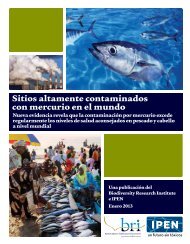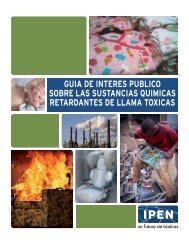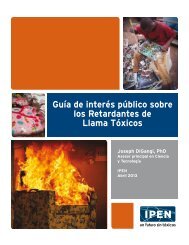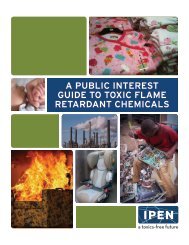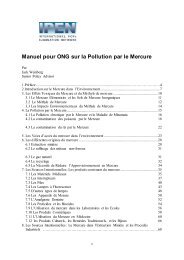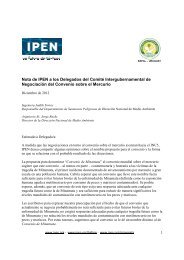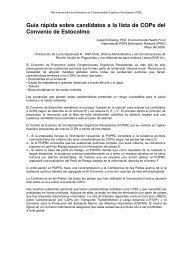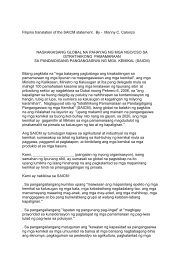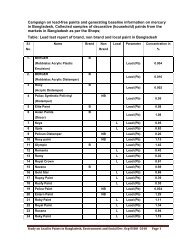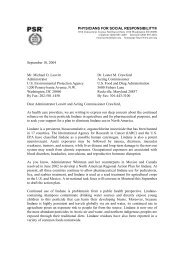The UNDP-GEF POPs Resource Kit - International POPs Elimination ...
The UNDP-GEF POPs Resource Kit - International POPs Elimination ...
The UNDP-GEF POPs Resource Kit - International POPs Elimination ...
Create successful ePaper yourself
Turn your PDF publications into a flip-book with our unique Google optimized e-Paper software.
Scientists researching population declines in wildlife made the first important<br />
discoveries about the harm <strong>POPs</strong> cause. <strong>The</strong>se scientists observed a range of health injuries<br />
in birds, fish and mammals, and they discovered that these injuries were associated with<br />
<strong>POPs</strong> in the environment. Predator species often suffered the greatest harm: species whose<br />
diet is largely meat and fish.<br />
Wildlife species exposed to <strong>POPs</strong> in the environment may exhibit any of a number of<br />
different kinds of injury. <strong>The</strong>se include:<br />
• Reproductive failure and population declines;<br />
• Abnormally functioning thyroids and other hormone system dysfunctions;<br />
• Feminization of males and masculinization of females;<br />
• Compromised immune systems;<br />
• Behavioral abnormalities;<br />
• Tumors and cancers; and<br />
• Gross birth defects.<br />
Many scientists noted that <strong>POPs</strong> also are widely present in human food. This raised<br />
the question: if <strong>POPs</strong> injure wildlife, do <strong>POPs</strong> also cause injury in humans?<br />
When scientists and medical researches looked into this question, they determined<br />
that the answer is: “Yes!”<br />
Scientists analyzed human tissue samples and human blood samples. <strong>The</strong>y found that<br />
<strong>POPs</strong> and other man-made toxic chemicals are present in the bodies of people, everywhere.<br />
Some groups of people are especially contaminated. <strong>The</strong>se include farmers and<br />
workers who are exposed to <strong>POPs</strong> in their occupations. Subsistence hunters and fishers in<br />
some regions are also sometimes highly exposed.<br />
Human exposure to <strong>POPs</strong>, however, is not limited to specific occupations or to<br />
certain regions. <strong>POPs</strong> can be found in the blood and in the tissues of the general human<br />
population in all parts of the world. As a result, <strong>POPs</strong> are now a legitimate and important<br />
cause for concern, everywhere.<br />
6 ----------------------------------------------------------------------------------------<strong>UNDP</strong>-<strong>GEF</strong> <strong>POPs</strong> <strong>Resource</strong> <strong>Kit</strong>



